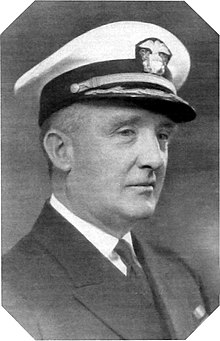Charles P. Snyder (admiral)
| Charles P. Snyder | |
|---|---|
 |
|
| Birth name | Charles Philip Snyder |
| Born |
July 10, 1879 Charleston, West Virginia |
| Died | December 3, 1964 (aged 85) Bethesda, Maryland |
| Allegiance |
|
| Service/branch |
|
| Years of service | 1900–1946 |
| Rank |
|
| Commands held | Battle Force |
| Battles/wars |
World War I World War II |
| Awards | Navy Cross |
Charles Philip Snyder (July 10, 1879 – December 3, 1964) was a four-star admiral in the United States Navy who served as the U.S. Navy's first Naval Inspector General during World War II.
Born in Charleston, West Virginia in Kanawha County to future West Virginia Congressman Charles P. Snyder and Jane Goshorn, he attended Washington and Lee University for one year before entering the U.S. Naval Academy in 1896. Graduating fourth in his class in 1900, he served the standard two years at sea as a passed cadet before being commissioned ensign in 1902 and assigned to the battleship Alabama.
Promoted to lieutenant, he reported to the Naval Academy on August 16, 1905 as an instructor in navigation and mechanics. In February 1906, he was called before a Congressional subcommittee to testify about his role as the disciplinary officer in charge during a notorious hazing incident that had resulted in an upper class man being acquitted at court-martial for the injury of a fourth class man on the grounds that he and other upper class men had understood Snyder to have tacitly encouraged the hazing.
During World War I, he commanded the battleship Oregon, flagship of the Pacific Fleet; the cruiser Minneapolis; and the transport Mongolia. He graduated from the Naval War College in 1925. Promoted to captain, he served as commandant of midshipmen at the Naval Academy, on staff at the Naval War College, and as manager of the Portsmouth Navy Yard.
...
Wikipedia
